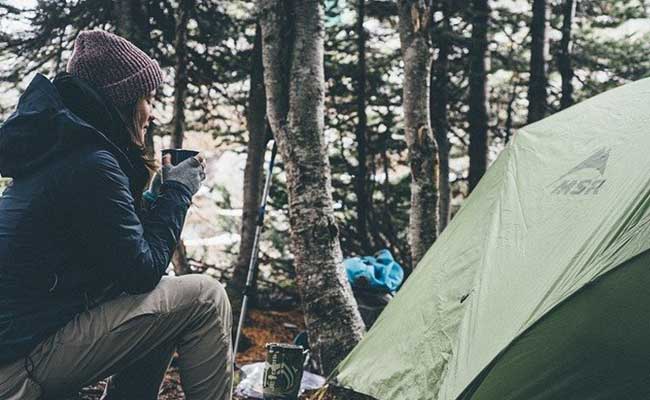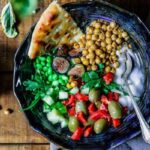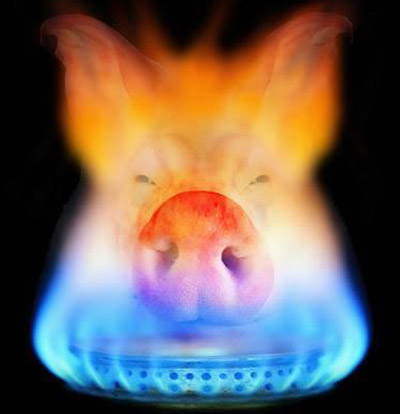Natural disasters and emergencies are rare but worrisome. Worse than the worry, though, would be experiencing one unprepared.
That's why preparation is crucial, and even more so if you're vegan!
When food is scarce you have to eat whatever you can, and that may mean non-vegan foods. But if you prepare properly, you should be able to avoid that outcome by seeing the disaster through with plant-based supplies.
Whether a heavy storm that leaves you without electricity, gas and water, or a global pandemic that knocks out supply chains and leaves your family without food for weeks on end, it pays to be a vegan prepper!
Follow the tips below to start building your vegan survival kit.

Don't live in fear of the worst, be prepared and live with confidence.
Preparing a Vegan Survival Kit
How Much Food Should I Prepare?
By creating your own vegan emergency food kit you can ensure adequate nutrition in a disaster situation.
Your disaster kit should consist of foods that do not need refrigeration and require little preparation or cooking and little to no water.
The amount of food you prepare will depend on the type of emergency or disaster you are anticipating. However, the ideal practice is to prepare at least four weeks worth of food. If possible, prepare for 3 months.
You don't need to stock up in one go. Instead, you can gradually accumulate supplies each time you go grocery shopping.
What Types of Food Should I Prepare?
Fortunately, many vegan foods are naturally shelf-stable and easy to prepare. These foods can be made tastier with simple condiments. There are also many vegan snack foods that are highly nutritious.
Dried foods make a fantastic option for emergency kits because they are lightweight and easy to store. Aside from having a long shelf life, dried foods also require little preparation, which is key, since your ability to cook in a disaster situation will be greatly reduced.
Foods to Stock Up On
Grains
Grains provide substantial calorie intake and nutrition. Whole grains are better sources of fiber and other important nutrients, such as B vitamins, iron, folate, selenium, potassium and magnesium. They are easy to cook too, as long as you have water.
The most affordable and long-lasting grains are rice and quinoa. Oats and pasta can last up to two years. When choosing rice, note that white rice is more shelf-stable, but brown is more nutritious.
Nuts
Nuts are a valuable source of everything from iron and calcium to B6 and protein. If you freeze nuts, most varieties – except pine and pistachio – can be eaten up to a year past their best before date.
Good options are peanuts, almonds, cashews, and walnuts.
Vegan Snacks
Regularly renew a supply of granola bars, energy bars, vegan jerky, and crackers. These are good on the go options that will, along with nuts, keep you going until you are able to cook a meal.
Main Meal Protein Sources
Nearly every food has some protein in it, and if you're eating a balanced diet of grains, vegetables, fruits and nuts you'll certainly be getting all you need. However, you'll want to eat a dense protein source with your main daily meal.
If you end up in a disaster center there will be free food, but the protein sources are likely to be animal based. The same may apply to staying at someone's house, and certainly if you have to hunt.
Fortunately, stocking up your disaster kit with vegan protein sources is easy.
Note that dried foods are lighter to carry and large quantities are easier to store. On the other hand, canned foods can be eaten with little preparation and without cooking. I'd advise having access to both.
You can choose from the following dried foods for your survival kit:
- Dried beans
- Dried chickpeas
- Dried lentils
- Dried mushrooms
- Textured vegetable protein
- Shelf-stable tofu
- Protein powder (like Nuzest)
Canned goods are heavier and take up more space than dried goods, but they do not typically require water for preparation or consumption.
Consider the following:
- Canned fruits such as prunes, apricots, mandarins, mangoes, pineapples
- Canned green beans, peas, spinach
- Canned carrots, corn, tomatoes, and mushrooms
- Canned soups
Pro tip: Save the water from canned beans and use it for cooking or rehydrating frozen food. For canned fruit, you can drink the juice for extra hydration and nutrition.

You may have to camp out for a few days, or a few weeks!
Ingredients for Cooking & Preparation
Flavor is important, especially if you've got kids! Moreover, some flavorings provide additional nutritional content.
Add the following ingredients to your kit:
- Bouillon cubes made from vegetables – an easy way to add vitamins and minerals to food
- Iodized Salt (an iodine source)
- Nutritional yeast – a rich source of B vitamins, including B12
- Coconut milk powder – a lightweight alternative to milk
Other condiments you can include:
- Ketchup and mustard sachets
- Soy sauce
- Hot sauce
- Sugar
- Nut butter
Pro tip: Save the condiment sachets you get when you order takeout and add them to your survival kit. You can rotate the sachets with newer packs as and when you get takeout food.
Water & Drinks
Depending on age and health, humans can survive for 8 to 21 days without food and water and up to two months if there's access to adequate water intake (1).
This makes water the most important thing in your vegan survival kit.
Water may be cut off or contaminated following natural disasters like earthquakes and floods. Moreover, it might take a few days for emergency services to reach your neighborhood and sort out any issues disrupting your clean water supply.
It's therefore recommended that you prepare the following:
Store one gallon of water per person (and animal companion) per day for at least three days. If possible aim for more. If you have access to a vehicle during the emergency you will be able to transport a greater amount.
Remember that individual needs can vary and you may use water for reasons other than staying hydrated, such as cooking or washing dishes.
Plant milks are worth stocking up on too, especially if you have kids, as these provide protein and are generally fortified with calcium and B12.
Most plant milks can be bought in long-life cartons and last up to a year. These milks can also be mixed with oatmeal or any other cereal.
Any other type of drink would be considered a luxury, and you don't want to stock up unnecessary weight.
Preparing Your Go-Bag
You need more than just food in an emergency, so let's have a look at essential considerations for a go-bag.
Ideally you will keep a go-bag at home and one in the car, just in case you were unable to retrieve it from either location. The go-bag is important in the event that you can't stay in your home and have to venture out.
If you're able to stay in your home then you may not have gas and electricity, so you will need to store alternative fuel sources by way of gas cylinders or propane tanks.
Indeed, it would be ideal to have food stored in both locations too, and some essential foods in the go-bag too, just in case you are unable to retrieve your main stash of food.
Whatever you decide, the go-bag needs to be carry-on and something you can wear on long walks. Each member of the family may have their own go-bag, and this will help share the load. Even kids can have a small rucksack.
16 Go-Bag Considerations
Here's a list of other things to consider for a go-bag:
- A tent to accommodate all the family.
- Basic meds such as paracetamol and ibuprofen, plus any prescription meds you take
- First aid kit
- Originals and copies of important documents (passport, ID card, birth certificate)
- Glasses / contact lenses
- Leather-free gloves for all the family – get a tough pair that are built to last and can be worn for practical tasks such as building a camp or fire.
- Spare mobile phone battery and power banks
- Tape: Aside from using it to tape things together, you can use tape to repair tents and mosquito nets.
- Rope and string: Useful for tying down tarp, climbing, building shelter, tying things together, etc.
- Plastic bags: Plastic bags keep things dry and can provide shelter. The bigger the better, but take a variety of sizes.
- Sealer bags: These will keep food fresh and safe from insects once opened.
- Dryer lint: This is highly portable, lightweight, and remarkably effective as a fire starter.
- Torch: Battery-powered light source and extra batteries. Solar-powered is also an option depending on how much sun you get in your part of the world.
- If you have kids: Include diapers, wipes, shelf-stable baby food and multi-vitamins.
- Recent backups of your computer
- Other useful items: Can opener, scissors, matches, mirror, and whistle.
Pro tips: You will need gas in your car, which you may not be able to get when disaster hits. Make sure you've always got at least half a tank. Never drive on almost empty!
Storing Your Vegan Survival Kit
After selecting and gathering food items for your survival kit, you will need an efficient method for storing and/or transporting that maximizes both preservation and quality.
An emergency food kit that is properly sealed ensures that food is preserved and supplies are not damaged. Make sure you use proper long sealer bags designed for long-term storage.
+ Check out these Mylar Ziplock Bags
For storage I recommend using a heavy-duty plastic storage bin with a locking lid. One with wheels is ideal, as it will be easy to move when it gets heavier. You can also wheel it out to your car in an emergency.
In the event of an emergency, you will likely add your gear to backpacks, and the heavier items like water and tents will go straight into the car. However, the storage bin is a neat way to store goods and keep rats and mice away from your foods if you are using a shed or garage to store your stuff.
Make sure your container has at least one layer of heavy items at the bottom, like liquids and canned goods. This will prevent your dried goods from getting crushed. Add lighter-weight dried goods and other supplies on top.
Place your battery-powered torch on top for easy access, as this is the first thing you will need if the electricity goes out.
To minimize the chance of rats or mice getting at your food, seal up any holes in the walls or ceiling of your garage or shed. Check your bin monthly for damage and signs of deterioration.
Lastly, keep your survival kit away from heat and direct light to avoid food spoilage.
Pro tip: Fill up your car gas tank regularly, especially when you know a storm is coming in. If the electricity goes out, it will be impossible to get gasoline because pumps are powered by electricity.
A Word On Pets
A pet is part of the family and requires consideration too.
The main considerations are food and warmth.
A dog with a thick coat will do well without heating in the winter, but some breeds may suffer. Cats generally do fine too, except short-haired breeds and kittens.
If your pet has a special food then make sure you are always stocked up.
Here's a quick pet survival checklist:
- Dried food (kibble) – because it keeps longer
- Warm blanket and bedding
- Prescription medication (if applicable)
- A portable drinking bowl
- An extra collar and leash (keep in the car)
- Tick/flea spray
A Final Word on Vegan Survival Planning
Prepping tends to be seen by some as “extreme” and worrying unnecessarily. But as with have seen with COVID-19, disruption to supply chains can see essential items quickly disappear from store shelves.
We are over reliant on the government to deliver our food. No one grows and stores food anymore, so if the government are unable or unwilling to fulfill their supply chain duties then we will starve.
No one should be naive enough to rely on local authorities or the army to bring them food and offer shelter during a disaster. These people have families too, and they will prioritize their families if they aren't safe.
A lot of produce comes from abroad, too. If people in foreign countries can't work due to a pandemic or other disaster, they can't produce and deliver food.
Crop failures can occur because of extreme weather, and supply chains are affected by a global pandemic, a war, and hyper-inflation. While rare, we have seen these things happen in other countries, so it makes good sense to be prepared.
As a vegan with specific dietary requirements, you will want to survive for as long as possible without eating animal products, though unfortunately that is a prospect we must prepare for. At the end of the day, we must survive.
No Time to Prep Your Vegan Survival Kit?
Prepping does take up quite a considerable amount of time. It takes time to create your emergency kit and establish your supplies.
You will need to regularly check your supplies and replenish your stock to rotate out the foods that are getting closer to their expiry date.
Thankfully, you can invest in a vegan food supply kit that provides food with a long shelf life and comes in protective packaging.
Have a look at these two options:
Option 1:
The first kit is from Northwest Fork.
It has a 10-year shelf-life and 90 servings that last 30 days.
The wonderful thing about this kit is the packaging. The food comes in resealable, stand up bags, making it easier to store and lighter to carry.
It's not just vegan, but also Kosher and non-GMO.
That said, the calorie count is only around 1,250 per day (if active). For a higher calorie count see option 2.
Option 2:
This vegan survival kit is from The Food Storage Guys. These guys are specialists in survival and really know their stuff.
The kit has an incredible shelf life of 25 years. It provides 2,000 calories per day, over 3 months (1 person).
If you have are a couple, this will last 1.5 months, and 3 weeks for a family of 4.
The food comes in cans, which are hard wearing but heavier than Myler type bags. Each metal can comes with a plastic resealable lid that continues to preserve the food for up to one year after opening.




Great information. I would prefer celtic sea salt which has 84 minerals in it. Iodized salt is not
healthy and you get very little iodine in an excess of salt. Also stock a package of icelandic or maine
seaweed, or, liquid iodine, trace minerals, and B12, D3, and magnesium. I think everyone should have a good knife, headlamp, water purifier (like Katadyn, Berkey…), energy bars like shanti bars, and lots of batteries.
BTW, its’ may 2022 and there is a deliberate food shortage being created. Please stock 2-3 months
worth of grains, beans, pasta, nuts, dried fruit, pasta sauce, etcetera. When the shelves empty it will
take months for them to restock. cheers…….
May 06, 2022 at 11:25 pm
Hey Rachel,
I haven’t looked into celtic salt. Thank you for the tip. I agree on stocking food. I keep a cupboard of beans , pasta and other bits just in case. I also grow some food myself.
May 09, 2022 at 11:11 am